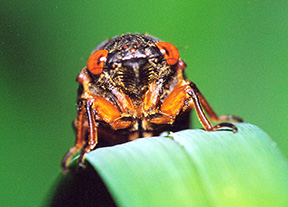Periodical cicadas are coming to northeastern Ohio and there is now a way to track, to photograph, and to help map these interesting insects on an mobile phone app created by cicada experts.

Periodical cicadas are coming to northeastern Ohio and there is now a way to track, to photograph, and to help map these interesting insects on an mobile phone app created by cicada experts.
Gene Kritsky, Ph.D., Dean of Behavioral and Natural Sciences at Mount St. Joseph University, who has studied cicadas throughout his academic career, worked in partnership with the Mount's Center for IT Engagement (cITe) to create the Cicada Safari App. The app allows users to search, photograph and help map the 17-year Brood VIII cicadas that will begin emerging in northeastern Ohio - as well as in parts of western Pennsylvania and northern West Virginia – starting in mid-May.
"Periodical cicadas are bugs of history," Dr. Kritsky said. "They are generational events, and many people use the emergence to mark the passage of time, recall key events in their lives, and just remember where they were and what they were doing the last time the cicadas arrived."
"We developed this app because so many people are fascinated by cicadas," he said. "This is true citizen science. People can use their phones with our app to track, photograph, and help us map the cicadas to verify where they are emerging. An issue with citizen science projects is the difficulty to verify new observations. The photographs submitted to our map are like voucher specimens permitting us to verify the observations making the maps more useful for future research."
To help map the 2019 emergence, simply go to an app store and download the Cicada Safari App. Use the app to photograph the insects and submit the pictures for inclusion on MSJ's 2019 Cicada Map.
A recognized cicada expert, Dr. Kritsky has given hundreds of media interviews, published academic papers on cicadas and is the author of two books on Cicadas, "Periodical Cicadas: The Plague and the Puzzle" and "In Your Backyard: Periodical Cicadas".
Following are some cicada facts from Dr. Kritsky's cicada web page:
- Cicadas emerge after the soil temperature exceeds 64 degrees, which is usually in mid May.
- Only male cicadas sign through sound-producing structures called tymbals on either side of the abdomen.
- Cicadas do not eat solid food, but do drink fluids to avoid dehydration.
- Cicadas do not sting or bite, and do not carry diseases.
- Periodical cicada years are quite beneficial to the ecology of the region. Their egg-laying in trees is a natural pruning that results in increased numbers of fruits in the succeeding years. Their emergence from the ground turns over large amounts of soil, and after they die their decaying bodies contribute a massive amount of nitrogen and other nutrients to the soil.
- Periodical cicadas are often incorrectly called locusts. Locusts are grasshoppers and cicadas are more closely related to aphids than grasshoppers.
Recent Sightings in the Media
News of Dr. Kritsky and his work on the Cicada Safari App have been sighted in the region's media, including in Columbus, Cleveland, and Akron, Ohio, as well as Pittsburgh, Pennsylvania. Locally, the story has been featured on WVXU and WCPO.
Photo courtesy of Gene Kritsky at Mount St. Joseph University (copyright Gene Kritsky).

